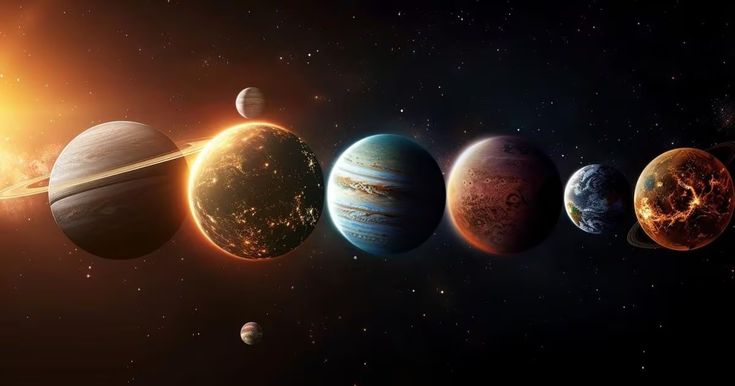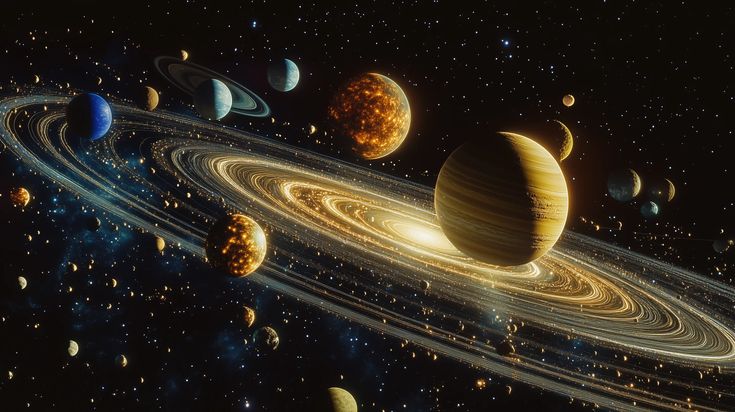A Timeless Journey Through Myth, Culture, and Astronomy
Have you ever looked up at the night sky and wondered how the planets got their names? Why do we call the red planet Mars, or the giant gas world Jupiter? Behind every planetary name lies a fascinating story—woven from ancient mythology, global tradition, scientific discovery, and even a bit of modern imagination.
Join us as we explore how our solar system’s planets earned their names, and why these stories continue to shape the way we see the universe.
The Planets We’ve Always Known

Long before telescopes or space probes, five planets could be seen with the naked eye—Mercury, Venus, Mars, Jupiter, and Saturn. Ancient civilizations noticed these bright “wandering stars” moving differently from the fixed stars in the night sky. The Greeks called them planētēs asteres, meaning “wandering stars,” a term that eventually became “planet.”
The Romans, influenced by Greek astronomy, assigned these moving lights the names of their gods—figures who symbolized power, emotion, and natural forces. Each planet’s observed behavior in the sky played a role in how it was named:
- Mercury, the fastest-moving planet, was named after the Roman messenger god known for his speed.
- Venus, shining brightly and often seen at dawn or dusk, was associated with the goddess of love and beauty.
- Mars, with its reddish hue, reminded observers of blood and battle, fitting the god of war.
- Jupiter, the largest and most dominant object in the sky besides the sun and moon, took its name from the king of the gods.
- Saturn, the slowest and farthest known planet in ancient times, was named for the god of time and agriculture.
This method of naming based on Roman mythology became a tradition that still influences how we name celestial bodies today.
What About Earth?
Unlike the others, Earth didn’t follow the same mythological pattern. Its name comes from Old English and Germanic words like eor(th)e and erde, meaning “ground” or “soil.” For most of human history, Earth wasn’t considered a planet at all—it was simply the world, the fixed stage upon which the heavens moved.
It wasn’t until the 16th century, when astronomers like Copernicus proposed that Earth also orbited the Sun, that it was finally classified as a planet—just like the others. Yet its name remained humble and literal, grounding us in our origins while the others soared with divine titles.

Discoveries That Changed the System
The invention of the telescope brought new planets into view, and with them, new naming challenges. When Uranus was discovered in 1781 by William Herschel, he originally suggested naming it after King George III: Georgium Sidus (George’s Star). Unsurprisingly, this was not well-received outside Britain.
Instead, the name Uranus was proposed by astronomer Johann Bode, aligning with the mythological theme. Uranus was the ancient Greek god of the sky, the father of Saturn, and grandfather of Jupiter—a perfect fit for a planet located beyond them.
When Neptune was discovered in 1846, its deep blue color inspired the name of the Roman god of the sea. There was some debate, but the name Neptune was quickly accepted, as it followed the mythological consistency already established in naming other planets.
Pluto: The Underworld’s Unexpected Guest
In 1930, a young astronomer named Clyde Tombaugh discovered a small, distant object beyond Neptune. The planet needed a name—and that honor went to 11-year-old Venetia Burney from Oxford, England. She suggested Pluto, the Roman god of the underworld, because of its dark and mysterious location at the edge of the solar system.
Pluto was welcomed into the planetary family for over 75 years until 2006, when it was reclassified as a dwarf planet. Still, its name lives on in science, pop culture, and public affection—proof that naming a planet can have a lasting emotional legacy.
Naming in the Modern Age3. Introducing Water and Life
Today, naming celestial bodies is handled by the International Astronomical Union (IAU), which sets strict guidelines to ensure consistency and clarity. This organization, founded in 1919, oversees the naming of moons, asteroids, comets, dwarf planets, and even exoplanets.
Their rules usually follow a theme. For example:
New exoplanets (planets orbiting other stars) are often labeled with catalog numbers, but sometimes given names through public contests—with cultural and historical significance.
Moons of Jupiter are named after lovers and descendants of the god Zeus.
Moons of Saturn include figures from Norse, Gallic, Inuit, and Roman mythology, based on their orbits.

Beyond the West: Global Naming Traditions
It’s important to recognize that not all planet names come from Roman or Greek mythology. Around the world, different cultures have developed their own naming systems for the planets:
In China, planets are associated with the five elements—wood, fire, earth, metal, and water. Venus, for example, represents metal, while Mars is fire.
In India, planetary names are rooted in Vedic astrology and Hindu mythology. Mercury is called Budha, Venus is Shukra, and Mars is Mangala—each with its own story and symbolism.
These traditions offer rich, alternative perspectives on our solar system, showing how humans across the globe have interpreted the skies based on their unique beliefs and values.
Why Planet Names Matter
Naming a planet isn’t just about labels—it’s about identity, imagination, and storytelling. When we call a planet Venus or Neptune, we’re not just describing its position or composition. We’re invoking centuries of myth, history, and discovery.
These names help us connect emotionally to the universe, turning cold rocks and gas giants into characters in the cosmic story. And as we continue exploring space, discovering thousands of new worlds, we’ll need even more names—new myths, new stories, and new ways to understand our place among the stars.


